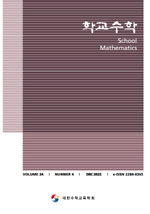본 연구는 연속체의 역사적 발달과정을 분석하고, 이를 바탕으로 하여 실수의 연속성에 대한 교수학적 시사점을 논의한 것이다. 역사적 분석 결과로 다음을 확인하였다. 첫째, 실수를 구성하는 과정은 무한에 대한 이해와 정당화를 둘러싼 오랜 시간이 걸린 매우 험난한 과정이었다. 둘째, 귀류법은 완비성이 실수를 구성하는 다양한 방법과 서로 동치임을 밝히는 데 전제가 되는 조건이다. 이에 대한 교수학적 함의는 다음과 같다. 첫째, 유리수로부터 실수를 구성하는 방법은 직관적 이해부터 수학적 정당화까지의 다양한 수준으로 구분될 수 있으며, 학생들의 이해 수준에 적절한 교수학적 조치가 제공되어야 한다. 둘째, 실수의 연속성은 수직선 모델로 직관적으로 설명할 수 있다는 장점이 있지만 유리수와의 차별성을 드러내기에 부족하며, 이를 위한 대안적인 방법이 필요하다. 이러한 연구결과는 실수의 연속성에 대한 교수학습에 유의미한 시사점을 제공한다.
This study analyzes the historical development process of continuum and discusses the pedagogical implications of continuity of real numbers based on this. As a result of historical analysis, the following was confirmed. First, the process of constructing real numbers was a very difficult process that took a long time surrounding understanding and justification of infinity. Second, reductio ad absurdum was a premise condition to revealing that completeness is equivalent to the various ways of constructing real numbers. Teaching implications for this are as follows. First, the method of constructing real numbers from rational numbers can be divided into various levels from intuitive understanding to mathematical justification, and pedagogical treatment appropriate to students' understanding level should be provided. Second, it is not enough to distinguish the properties of rational numbers from the continuity of real numbers in the number line model, so the alternatives need to be studied. These findings provide significant implications for teaching and learning about the continuity of real numbers.
I. 서론
II. 연속체의 역사
III. 연속체와 학교수학
IV. 결론 및 논의
참고문헌
